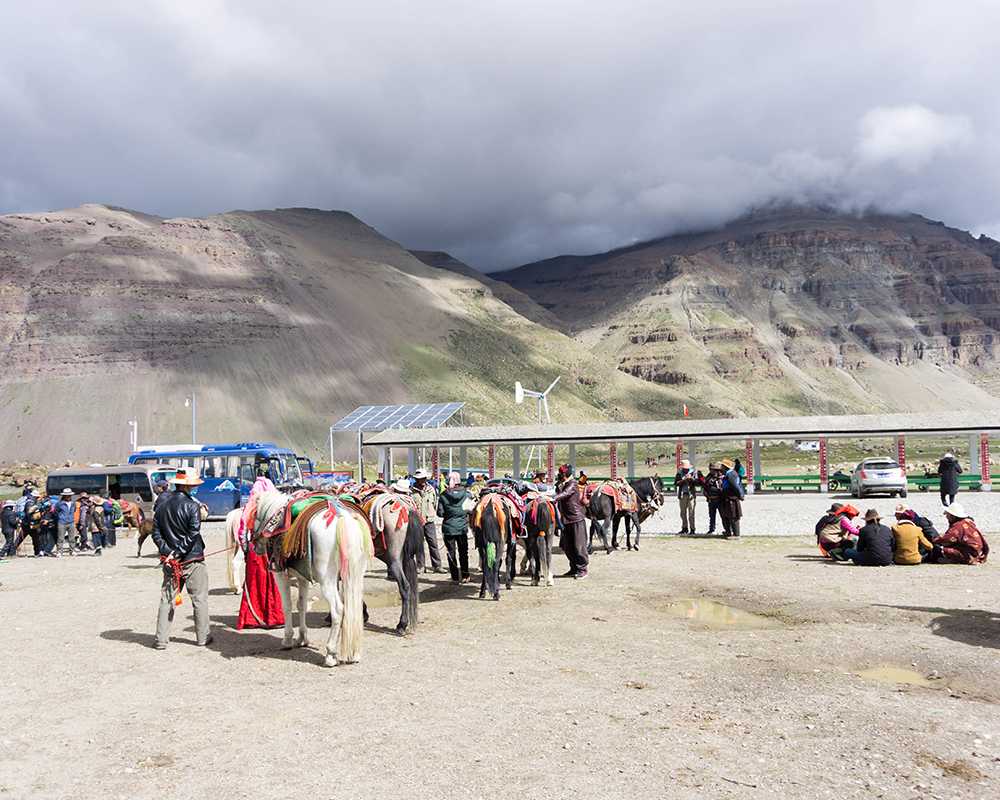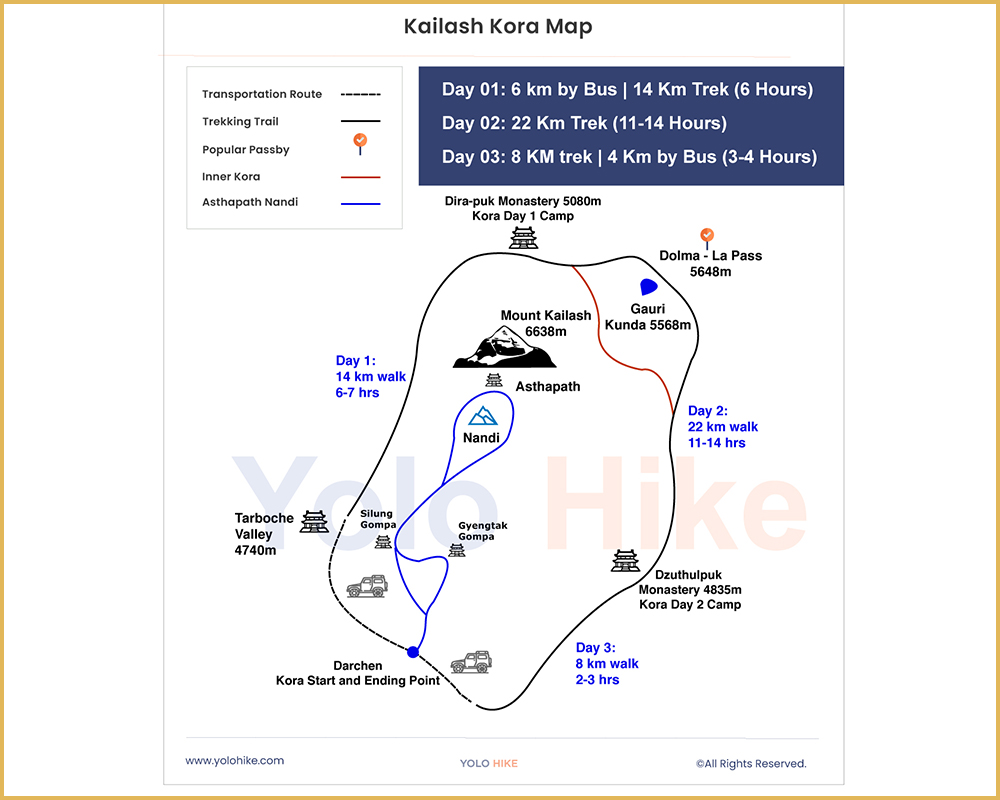Mount Kailash Kora is a spiritual pilgrimage route, encompassing the holy Mount Kailash in the remote western region of Tibet. The term "kora" means circumambulation, referring to the practice of paying respect to the sacred elements of the universe, especially mountains, monasteries, and lakes in Tibet. The Kora is considered a means of enlightenment and meditation by followers of Buddhism, Jainism, Hinduism, Bonpo, and other religions. The journey involves a clockwise circumnavigation of the Mount Kailash, which is believed to be the home of Lord Shiva in Hinduism. The trek lasts for three to four days, covering 52 km of challenging terrain and high altitude. The Inner Kora is a quicker but more difficult route of 22 km, while the Outer Kora takes 24 km to complete. The pilgrimage is emotionally and spiritually challenging, but it presents an opportunity for spiritual growth, enlightenment, and atonement.
Mount Kailash Kora: Exploring the Enlightenment
Table of Contents
Mount Kailash Kora is a pilgrimage route for followers of Lord Shiva and other spiritual seekers in the undeveloped and remote region of western Tibet (an autonomous region of china) during the Kailash Tour. The Tibetan term "kora" literally translates to "circumambulation" or "revolution" in English. Kora also refers to the Tibetans' practice of demonstrating respect for the holy and sacred elements of the universe.
The mission involves traveling around the holy Mount Kailash, which is treasured by followers of the Buddhist, Jains, Bonpo, Hindu, and other faiths. It is a pilgrimage and a means of enlightenment and meditation. The sacred aspect is mostly encircled in a clockwise motion to accomplish this. In Tibet, a lot of items, including mountains, monasteries, and lakes, are revered as holy. you will also see a prayer flag around the Kora flagged by pilgrims.
The Hindu pilgrims recite mantras and turn their prayer wheels as they make a clockwise circuit of the site. In addition, they occasionally bow down in front of the holy features when performing the kora. As a result, the kora is a ritual delicately adorned with the lives of both Tibetan pilgrims and regular citizens of Tibet.
There are numerous spirituals to Mount Kailash from different religions. The average length of the Kora is three days, and it covers a distance of around 52 kilometers. Due to the altitude and the fact that you will be passing through mountains and challenging terrain the entire way, this mount Kailash trek is challenging.
From ancient times, pilgrims from all over the world have been drawn to Kailash Kora. Mount Kailash Yatra as they pass lake Manasarovar is one of the hardest and most spiritually fulfilling excursions on earth. Inner Kora and Outer Kora are the two methods to approach Kailash Kora, which typically lasts three days. The Kora usually extends to four days if you include Asthapath Nandi or Charan Sparsha in your schedule.
The hallowed terrain of Kailash Kora and the many routes leading to the enlightenment that many pilgrims seek. The Kailash mountain trek circumambulates Mt Kailash, which is regarded as one of the most important sacred mountains in the world and is thought to be the home of Lord Shiva in Hinduism.

Kailash Kora route Overview
Day 1: The adventure starts in the little village of Darchen. You will go from here to the Tarboche flagpole, which symbolizes the beginning of the Kailash Kora. The Dirapuk Monastery, which is located at an elevation of 4,900 meters, is reached by a difficult ascent on the route. During the first day of Kora, the pilgrims can see the south face and see the west face of Mount Kailash as they move towards Derapuk Monastery.
One of the holiest places on the Kora is the monastery, which is said to have been established in the 11th century by the Tibetan yogi Milarepa. Here, one may spend an additional day and apply for a Charan Sparsha. It takes 6 to 7 hours to walk the 14 km on this day.
Day 2: The Inner and Outer Kora, which circles Gauri Kunda, are the destinations for the second day of the Kora. The Dolma La Pass, which is located at an elevation of 5,630 meters, will be crossed if you choose to take the outer Kora. Pilgrims will see a north face while they approach kora.
The journey's most difficult section is the pass, which is also the highest point on the Kora. It is said that passing across the Dolma La Pass will atone for your sins and grant you awakening. The Tibetan saint Gyalwa Gotsangpa is thought to have founded the Zutulpuk Monastery, which is reached by descending from the pass. It will take 11 to 14 hours to walk the 22 to 24 km on this day.
Day 3: The last day of the Kora entails a hike via the Dzutrulpuk Monastery back to Darchen. A cave is where the monastery is located. At this point, the trail gradually slopes down to Darchen, where you'll finish your Kailash Kora. Pilgrims can see the west face of Mount Kailash until they reach Dzutrulpuk. The 8 Kilometer distance on this day requires two to three hours of walking.
A powerful and life-changing event, the Kailash Kora presents a chance for enlightenment and spiritual development. The journey is intellectually and emotionally taxing in addition to being physically difficult. It necessitates a strong dedication to the spiritual path as well as the ability to let go of attachments and wants. You can see a provided Kailash Map of Kora to see the overview of the spiritual journey.

Inner Kora
The quickest way to circle Mount Kailash Parikrama is via the Inner Kora. It is roughly 22 km long and is followed by the mountainous inner path of Gauri Kunda (5568m). One can look closer at Mount Kailash's east face by passing through the Dirapuk Monastery.
Lord Shiva is thought to travel the Inner Kora when he performs the Tandava, his cosmic dance. The Kailash Kora's inner Kora is regarded as its most difficult section. Inner Kora, according to devotees, purifies the soul and moves one closer to enlightenment.
Outer Kora
The 24-kilometer-long Outer Kora is a longer route around Mount Kailash. This path, which is part of the second day of the Kora, passes through some of the most breathtaking scenery in the area. Despite being less revered than the Inner Kora, the Outer Kora is nonetheless a significant stop on the Kailash Kora journey. According to popular belief, the Outer Kora is a journey of self-realization and growth.
The Dolma La Pass (5648m), one of the highest passes on the trip, is where the goddess Dolma and Lord Buddha are said to have first met. The Outer Kora travels from the Gauri Kunda to this location, passing through it.
Asthapath
The Asthapath is an 8-kilometer-long, gentle, circular path that circles Mount Kailash. The gods are thought to follow this route to reach Mount Kailash and cross Nandi Peak (the bull of Lord Shiva and the mountain).
The Asthapath is a great alternative for individuals unable to complete the more difficult Inner and Outer Kora Parikrama because it may be completed by pilgrims in a single day. Asthapath can be an excellent alternative to take to go as close to Mount Kailash as possible since Charan Sparsha can be risky for pilgrims.
Nandi Pass
The Kailash Kora's Nandi Pass is among its more difficult sections. Just before the Asthapath, there is a high-altitude pass that is 5,630 meters above sea level. The past bears his name in honor of Nandi, the bull that served as Lord Shiva's chariot. Making the steep ascent to the pass takes a lot of effort and endurance. But once they cross the pass, they are blessed with breathtaking vistas of Mount Kailash and the neighboring Himalayan peaks.
Due to the pass's elevation and erratic weather, it can occasionally be dangerous. To complete the Nandi Pass trip, pilgrims must be both physically and emotionally healthy. Also, pilgrims think that the Nandi has been defending Mount Kailash, which contributes to the unpredictable nature of the weather and the repercussions of uncertain climate.
Charan Sparsha
Charan Sparsha is the holiest destination of the Kailash Kora pilgrimage. It is a small rock that lies at the base of Mount Kailash and is believed to be the footprint of Lord Shiva. Pilgrims touch the foot of Kailash and offer their prayers to Lord Shiva, seeking his blessings and enlightenment. Charan Sparsha is considered the most sacred part of the Kailash Kora pilgrimage and is believed to be the culmination of the spiritual journey.
One can take to a Charan Saprsa with an extra day and work on the second day to approach the Charan. It is believed that by touching the feet of Lord Shiva, one can attain enlightenment and liberation from the cycle of birth and death. The Charan Sparsha is a deeply spiritual experience that is sure to leave pilgrims feeling renewed and energized.

Conclusion
As a result, the Kailash Kora is a holy destination for pilgrims from all over the world. The difficult but enriching walk allows pilgrims to explore Mount Kailash's holy scenery and find enlightenment. The Kailash Kora presents its participants with both physical and spiritual difficulties. Trekkers have the chance to connect with the divine while traveling through some of the most stunning environments on earth.
Each of the trails that encircle the Holy Mount Kailash—the Inner Kora, Outer Kora, Asthapath, Nandi Pass, and Charan Sparsha—offers a distinct and life-changing experience.
It is crucial to psychologically and physically prepare for the journey before starting the Kailash Kora. The Kailash trekking requires arduous walking at high altitudes for several hours each day. To ensure you are physically prepared for the Kora, we advise you to work out regularly, train, and speak with your doctor before the trip.


